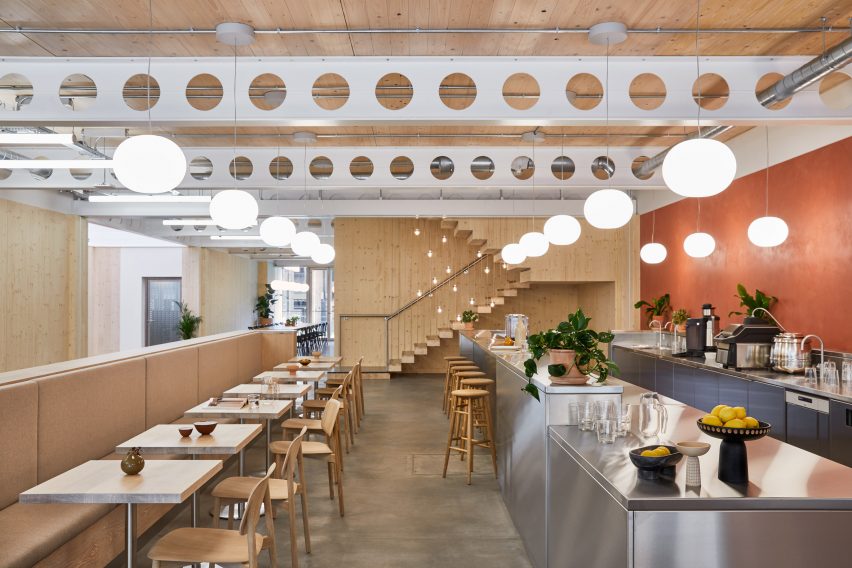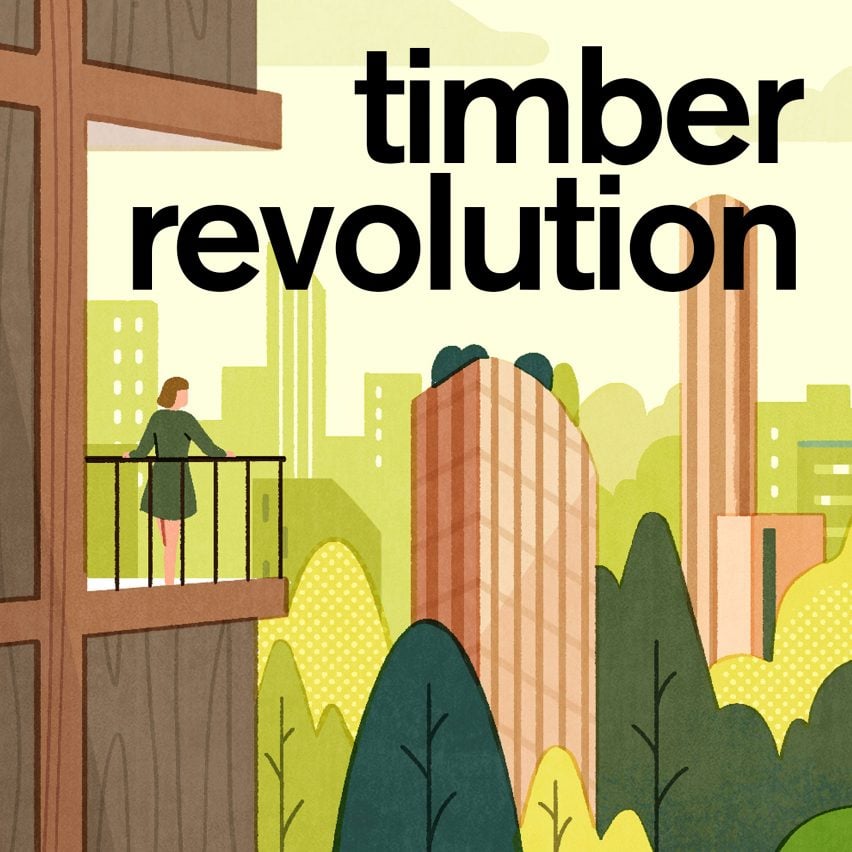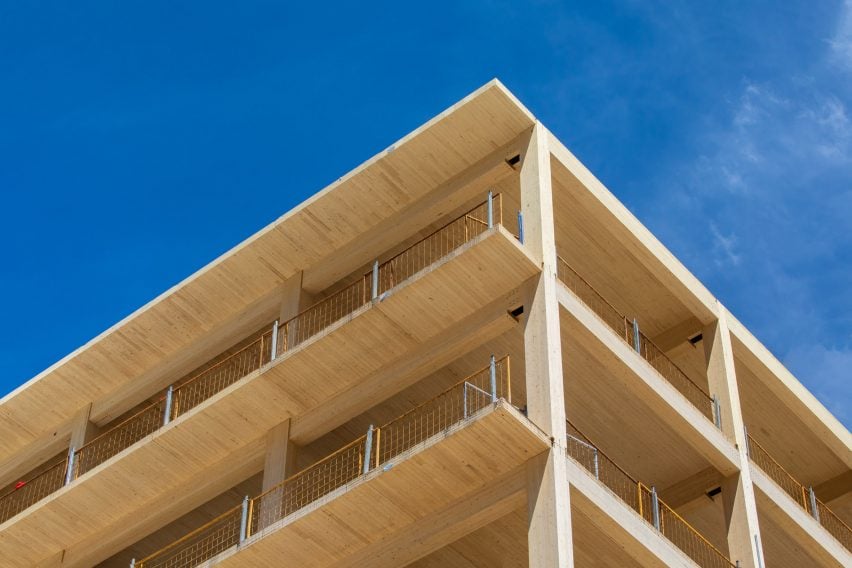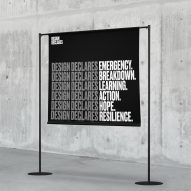The hidden environmental impacts of getting mass timber wrong
Architects are increasingly using mass timber in the hopes of creating net-zero buildings but carbon assessments are missing key sources of potential emissions, researchers tell Dezeen in this Timber Revolution feature.
The standard method for determining a building’s overall carbon footprint is a whole-building life-cycle assessment (LCA) that breaks down emissions at every stage – from the sourcing of raw materials to their ultimate disposal.
These calculations tend to indicate significantly lower emissions for timber structures compared to those made entirely out of concrete and steel. But experts warned that LCAs only tell part of the story.
“LCAs do not typically consider anything that happens in the forest,” said forester and timberland manager Mark Wishnie.
“And the land management side is, from a climate perspective and a biodiversity perspective, enormously important,” added Steph Carlisle of the Carbon Leadership Forum research group. “That’s really where all the action is.”
End-of-life “very, very important”
Because so few mass-timber buildings have been constructed – let alone demolished – researchers are also unable to reliably forecast what will happen to engineered timbers at end of their life and what emissions this would entail.
“There’s not a lot of data available to predict end-of-life and that can be very, very important,” Wishnie said.
This leaves both researchers and architects with an incomplete picture of mass timber’s climate impacts, which urgently needs to be addressed if the industry is to scale up sustainably without adverse effects on the environment.

“We need better transparency and traceability,” Carlisle said. “When architects use tools and they don’t necessarily know what’s going on behind them, they can really mislead themselves about the real emissions.”
“If we get this right, it has such incredible potential,” added Robyn van den Heuvel of the Climate Smart Forest Economy Program. “Not just for the built environment but also to ensure forests are sustainably managed.”
“But there are incredible risks of getting this wrong. It could result in the exact opposite effects of what we’re trying to create.”
Badly harvested timber has higher embodied emissions
Timber’s climate potential lies in its ability to sequester large amounts of CO2 from the atmosphere during its growth – in contrast to common building materials like concrete and steel, which mostly just produce emissions.
As a result, mass timber has been widely hailed as a way to help architects make their buildings net zero and, by extension, help the built environment mitigate the 13 per cent of global emissions that stem from the construction of buildings and the materials used in the process.
Research indicates that substituting wood for steel and concrete in mid-rise buildings could reduce emissions from manufacturing, transport and construction by between 13 and 26.5 per cent, depending on the building’s design, the exact wood products used and where they are shipped from.
But due to a lack of data, the International Institute of Sustainable Development (IISD) has warned that LCAs can gloss over the huge impacts that forest management and end-of-life can have on the overall climate impact of a mass-timber product.
Forest management is an important part of the equation, not just because it can help to prevent deforestation and protect biodiversity but also because it has a huge impact on a forest’s ability to act as a carbon sink.
Felling all the trees in a forest at the same time, in a method known as clear-cutting, can generate significant emissions by disturbing the soil and releasing the carbon it stores, which accounts for almost 75 per cent of a forest’s total carbon stock.
When this is combined with other harmful practices such as converting old-growth forests into tree plantations, this could actually make a timber building more emissions-intensive than a concrete equivalent, the IISD suggests.
“It’s neither true that all wood is good, nor that all wood is bad,” said Carlisle. “Architects really need to understand that it matters where your wood comes from.”
Forest certifications falling short
However, none of these important land-management impacts – whether good or bad – are reflected in typical life-cycle assessments.
“They don’t account for an increase in forest carbon stock or a decrease in forest carbon stock, an increase in forest area or a decrease in the forest area,” said Wishnie.
“Often, if you’ve got that wrong, it doesn’t matter what else is happening in the value chain, you already have a bad carbon story,” agreed van den Heuvel, who leads the non-profit Climate Smart Forest Economy Program.
To some extent, these concerns are addressed by forest certification schemes – the most comprehensive being FSC, which covers crucial factors such as forest health, biodiversity, water quality, and Indigenous and workers’ rights.
But these certifications do not require forestry companies to track and quantify how different management practices impact the carbon stock of a forest, which makes them impossible to represent in the LCAs used by architects and building professionals.

“Right now, I have no way of representing FSC-wood accurately in a life-cycle assessment model,” said Carlisle, who is a senior researcher at the Carbon Leadership Forum.
“There’s a lot of work happening on the certification side to do that research and publish it so it can come into our models. And we really need it because it’s not going to be sufficient in the long run for certification to be a stand-in.”
FSC certification is applied to 50,000 companies globally, making it harder for architects to discern which of these companies provides the best forest management and the most sustainable, lowest-carbon product so they can vote with their wallets.
“As the user, I can’t really make choices,” said Simone Farresin, one-half of design duo Formafantasma. “I can’t evaluate if one seller is better in community support or another in sustainable growing. It’s certified and that’s it. It’s not specific.”
“When you’re looking at materials, you have all these different grades of quality,” he continued. “And we need to reach the same in terms of sustainability – we need to be able to detect these different grades.”
“No consensus” over end-of-life emissions
Another area that is lacking in reliable information, and therefore hard to represent in LCAs, is what happens when a mass-timber building is demolished.
“There is a lot of debate about how to model end-of-life and it gets really contentious really quickly,” said Carlisle. “There is no consensus. The fight is very live.”
If a building was designed for deconstruction and its timber components are reused, this could offer substantial carbon and ecosystem benefits – providing continued long-term carbon storage while reducing the need for renewed logging as well as for emissions-intensive steel and concrete.
A small number of architects have begun to deliver demountable mass-timber buildings to facilitate material reuse, such as Waugh Thistleton’s 6 Orsman Road in London.
However, most timber demolition waste today ends up in either landfills or incinerators, with both scenarios resulting in some net emissions.
“Depending on what country you’re in, that waste looks very different,” said van den Heuvel. “But that also has a really massive impact on your total carbon story.”
In the case of incineration, all of the carbon stored in the wood would be released into the air, negating any storage benefits but potentially generating renewable electricity in the process if burned for biomass energy.
In a high-quality modern landfill, on the other hand, engineered wood products are estimated to lose only around 1.3 per cent of their carbon, although part of this carbon is released as methane – a powerful greenhouse gas that is 80 times more potent than carbon dioxide over a 20-year period.
“This is counterintuitive to people,” Carlisle said. “But you see very small emissions at end-of-life from landfills because that material is largely considered sequestered and stored permanently.”
“We can’t aim for perfection”
Crucially, estimates about end-of-life emissions are mostly based on products like medium-density fibreboard (MDF), which are less elaborately engineered than structural materials such as cross- and glue-laminated timber and so may respond differently.
“There is more uncertainty around what will actually happen at end-of-life because there are so few mass-timber buildings,” Carlisle said.
Researchers and institutions such as the Carbon Leadership Forum and the Climate Smart Forest Economy Program are working hard to fill in these gaps. And ultimately, they argue that governments must set national and international standards to ensure responsible sourcing and disposal if we hope to accurately assess and realise mass timber’s climate potential.
But in the meantime, all parts of the timber value chain – from forest managers to manufacturers and architects – should be more transparent about their carbon accounting.
“I would hate to see a world in which we stop everything to make sure all the certification is perfect,” said van den Heuvel. “Because buildings are still going to get built. And if we’re not using mass timber, we’re using a product that’s going to be even worse for the environment.”
“We’re running out of time, so we can’t aim for perfection. We should aim for good enough and transparency around it so that others can improve.”
The top photo is by Maksim Safaniuk via Shutterstock.

Timber Revolution
This article is part of Dezeen’s Timber Revolution series, which explores the potential of mass timber and asks whether going back to wood as our primary construction material can lead the world to a more sustainable future.


